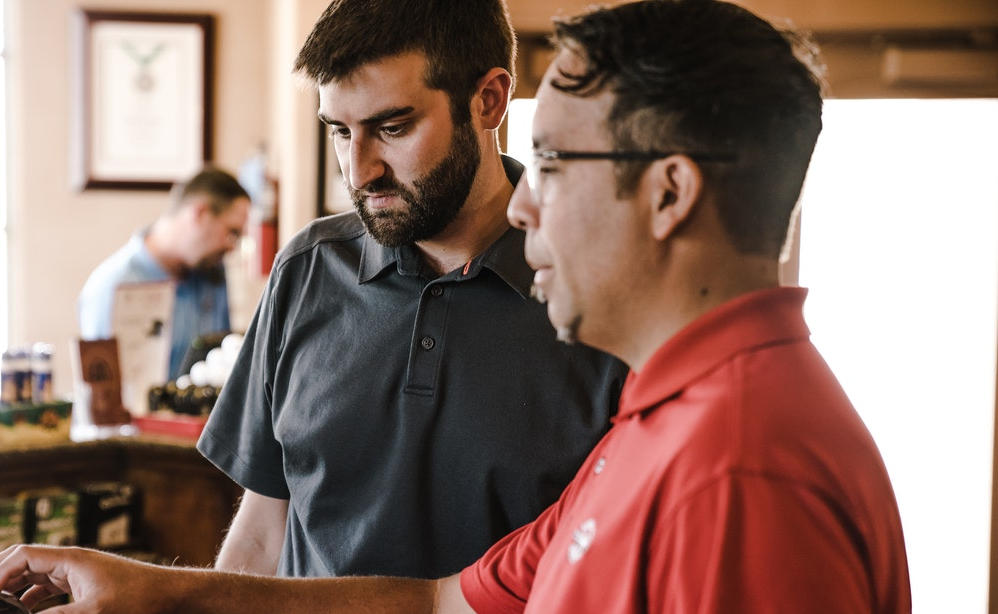[vc_row type=”in_container” full_screen_row_position=”middle” scene_position=”center” text_color=”dark” text_align=”left” overlay_strength=”0.3″ shape_divider_position=”bottom”][vc_column column_padding=”no-extra-padding” column_padding_position=”all” background_color_opacity=”1″ background_hover_color_opacity=”1″ column_link_target=”_self” column_shadow=”none” column_border_radius=”none” width=”1/1″ tablet_width_inherit=”default” tablet_text_alignment=”default” phone_text_alignment=”default” column_border_width=”none” column_border_style=”solid”][vc_column_text]Building a successful brand is much more than just making sure your company logo is displayed on all your signage. Brand consistency involves defining and controlling how the public sees your company do business and what core values they associate with your business. Your customers connect your business with your brand values according to how they personally experience those values in your locations. The more that actions inside your locations match the values in your messaging, the more consistent and powerful your brand will be – and the more brand trust and loyalty you can build.
For a quick glance at what we mean, let’s consider QuikTrip. Their branding includes the slogan “More than a gas station” – and that lines up with what their customers experience. They know they can drop into a QT and quickly choose from a consistent selection of hot food, self-serve drinks and convenience items; visit an ATM; and find a clean restroom. In other words, QT achieves of high level of brand consistency in customers’ minds by matching their words with their actions. Further, since customers know that every location they’ve visited is the same, they are likely to choose to stop at an untried QT (to get their usual drink and hot snack in a clean environment with polite, efficient employees) rather than risk stopping at one of QT’s competitors.
This is exactly why it’s so important to develop standards that demonstrate the consistency of your brand across all your locations. Every interaction your customers have within any location should clearly demonstrate your company values (and therefore your brand). To achieve this, you need:
- Clear communication that ensures your employees understand your brand.
- To establish exactly what actions to take and how employees should act within each location.
- A brand auditing system that is easy to understand and implement.
Here are a few best practices to build brand consistency between locations and drive customer loyalty across your brand.
1. Establish your brand values.
You have likely already talked about values as part of your branding message. The key here is to work through what actions your company should take, and what standards you should set, to visibly demonstrate your brand values to your customers. To use the QuikTrip example again, they claim on their website to value high standards of cleanliness – but what if their stores were visibly dirty? To take it one step further, would customers believe their claims if their employees weren’t neatly dressed in clean, standardized uniforms?
2. Ensure operations within each location are consistent.
From an operational standpoint, building consistency means standardizing retail items or services available in each location, stabilizing the supply chain that feeds each location, following the same employment practices and policies, and holding management to the same standards within each location. When issues arise, the process for reporting and improving them must also be consistent.
 3. Ensure that onboarding and training programs incorporate brand values.
3. Ensure that onboarding and training programs incorporate brand values.
The first and most influential audience for your brand are your employees. Without their buy-in and support, it will be very difficult to achieve brand consistency. However, with appropriate hiring, training and reinforcement programs, your employees become the magicians behind the success of your brand. To continue the observational examples, it seems likely that QuikTrip and Dutch Bros. each have detailed hiring practices and extensive onboarding programs to ensure that, while their customers interact with different employees at different locations, those employees are all behaving toward customers in a consistent manner.
4. Plan for a consistent customer experience.
The next step is to standardize the environment your customers will experience. This not only solidifies your brand in your customers’ minds, it also differentiates your brand from your competitors. Each location should be immediately recognizable, inside and out, as being a part of your brand. Everything from the physical elements within each location to the operational procedures to the way your employees greet each customer should be planned to inspire trust and confidence in your customers.
5. Audit, audit, audit.
Once your plan is in place to develop brand consistency, how are you going to make sure it’s in use, and remains in use, in every location? Again, our keyword is consistency: Only a standardized, consistent audit schedule will tell you exactly where your plan is working and where it’s lacking. This audit should encompass all the most salient points of your plan and should take place within each location as often as you find it reasonable. For some action items that display company brand values such as food safety or cleanliness, that action could take place multiple times in one day. Other actions, like displaying seasonal marketing campaigns, might only need to be audited once a quarter. Whatever the schedule, a mobile, digital audit system is your best option for tracking all the details and consolidating them into clear, real-time reporting.
Pro tip: If it’s boring…
The thing to remember about brand consistency is that, when it’s implemented correctly, it’s pretty boring to those inside your company who are used to it – which is good! After all, the reason you’re striving for brand consistency is so your customers trust they’ll have the same experience whenever they enter one of your locations – and that level of consistency only comes from doing each thing in exactly the same way in every location. Once your consistency is in place, any deviation from it will immediately glare into the trained eye of any auditor.
Ready to MeazureUp?
If you’re now concerned with how to achieve and maintain this level of consistency, then it’s time to consider MeazureUp. Our process activity monitoring solution focuses on ensuring consistency and sustainability across multi-unit enterprises and is designed to automate all your routine assessments, from food safety to compliance to branding. With a few taps and clicks, your auditors can quickly and easily document whether each location is complying with the procedures that ensure consistency and customer satisfaction. MeazureUp also features easy-to-use, built-in analytics that support better decisions and drive performance improvement across your locations. Contact us today to learn more.



